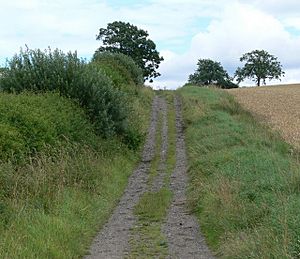Via Devana facts for kids
The Via Devana was an important Roman Road in ancient Britain. It stretched from Colchester in the southeast, through Cambridge in the middle, all the way to Chester in the northwest. These cities were major Roman military bases, so experts believe the road was built mainly for soldiers and supplies, not just for everyday travel.
The name "Via Devana" means "The Chester Road" because the Roman name for Chester was Deva. Colchester, another key city on the road, was called Colonia Victricensis, which means 'the City of Victory'. It's even thought to be the oldest Roman city in Britain!
After the last Roman legion left Britain in 407 AD, it became hard to keep up big public projects like roads. Because of this, the Via Devana slowly fell out of use. Today, it's quite difficult to find its exact path, especially in the northern parts. Some old maps don't even show it, but most historians now agree it existed. The name "Via Devana" was actually made up much later by a man named Charles Mason in the 1700s. He was a professor at Cambridge University and created a map of Cambridgeshire.
Exploring the Via Devana's Path
The Via Devana traveled north and west through many important places. Here are some of the main stops along its route:
- Colchester - Known to the Romans as Colonia Victricensis.
- Wixoe - Thought to be a possible Roman fort.
- Cambridge - The Roman name was Durolipons or Duroliponte. Today, the main road through Cambridge from the train station to Magdalene Bridge follows part of its path.
- Huntingdon / Godmanchester - Called Durolipus or Durovigutum by the Romans. Here, it crossed another famous Roman road called Ermine Street.
- Corby
- Medbourne - The section of the road from Medbourne to Leicester is broken in places. Where it still exists, it's known as the "Gartree Road" and "Evington Footway."
- Leicester - The Romans called this city Ratae Corieltauvorum. Here, the Via Devana met the Fosse Way, another major Roman road, before continuing on its own path.
- Mancetter - Known as Manduessedum, where it joined Watling Street, another important Roman road.
- Water Eaton - The Roman name was Pennocrucium.
- Newport, Shropshire - Called Plesc by the Romans, meaning a fortified place. From here, it followed a similar path to today's A41.
- Whitchurch, Shropshire - The Roman name was Mediolan or Mediolanum.
- Chester - The final destination, known as Deva to the Romans.
Images for kids
See also
 In Spanish: Vía Devana para niños
In Spanish: Vía Devana para niños



